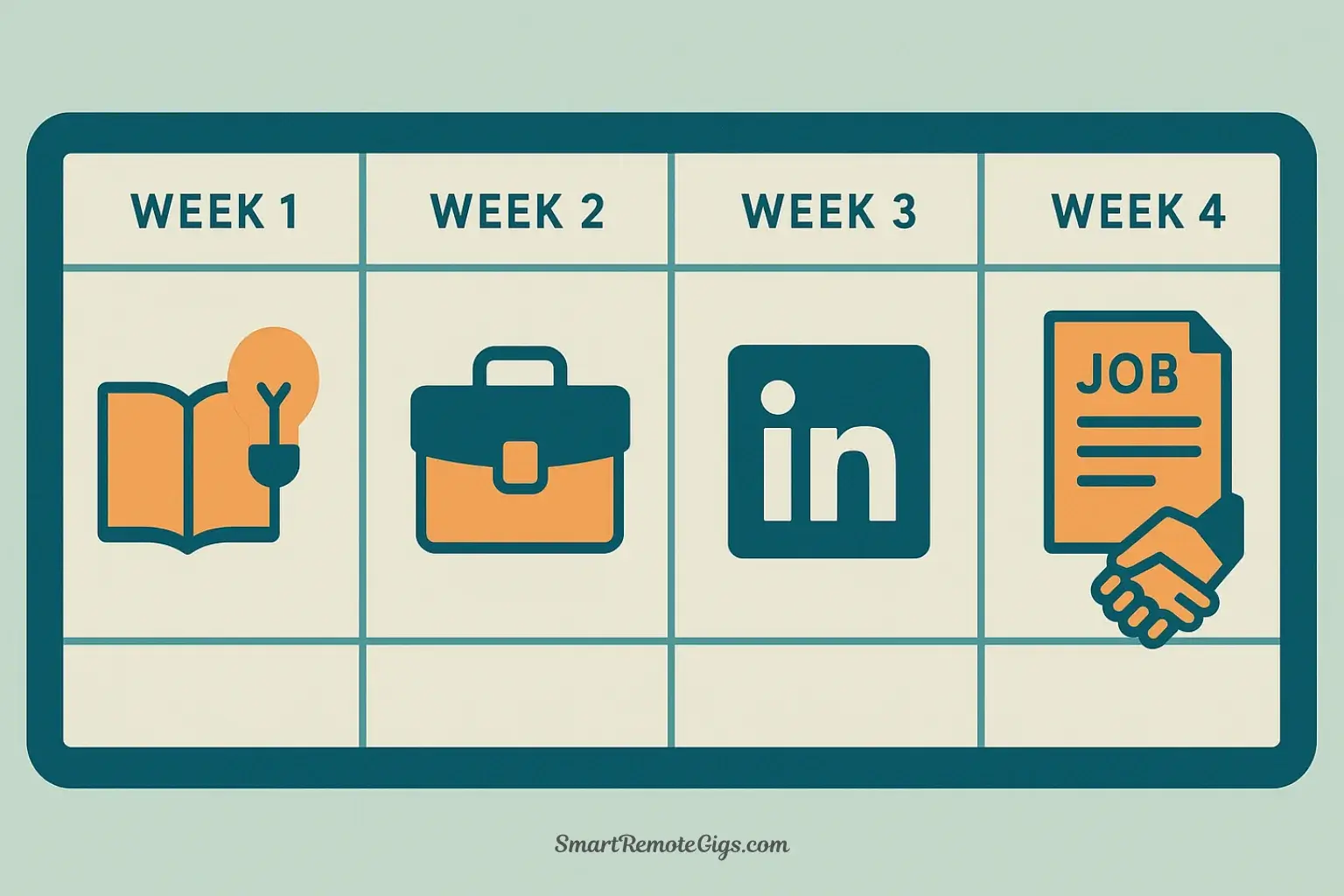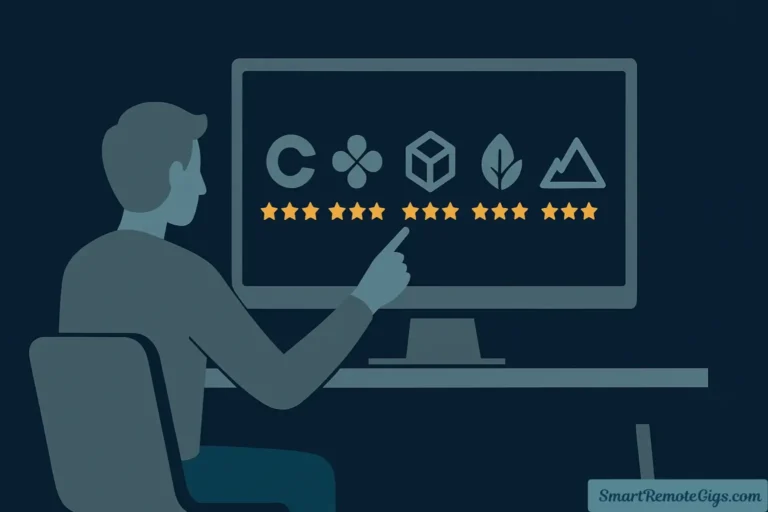You’ve scrolled through dozens of job postings for remote social media jobs no experience, only to find that every single one asks for “2-3 years of experience” or a “proven track record.” It’s the classic catch-22: you need experience to get hired, but you need to get hired to gain experience.
Here’s the truth: what hiring managers really want isn’t years of experience—it’s proof that you can do the work.
And you can create that proof in just four weeks, even if you’ve never managed a social media account professionally.
This guide provides a week-by-week action plan that transforms you from a complete beginner into a confident applicant with a portfolio, optimized profile, and clear strategy for landing entry-level remote social media jobs. No vague advice or overwhelming theory—just concrete tasks you can complete each day to build the exact credentials hiring managers are looking for.
By the end of this social media manager 4 week plan, you’ll have real projects to showcase, an optimized online presence, and applications submitted to companies actively hiring. Let’s get started.
Week 1: Foundation & Skill Building

The first week is about building your knowledge base and getting clear on your direction. You’re not trying to become an expert overnight—you’re establishing enough foundational understanding to speak confidently about social media strategy and execute basic tasks.
Monday: Choose Your Niche
One of the biggest mistakes beginners make is trying to be a social media manager for “everyone.” Specializing in a specific industry or business type makes you more attractive to employers and helps you develop deeper expertise faster.
Your Task: Select one niche where you’ll focus your initial efforts. Consider industries you already understand (former jobs, hobbies, education) or are genuinely interested in learning about. Popular niches include:
- B2B Tech & SaaS: Companies selling software to other businesses
- E-commerce & D2C Brands: Direct-to-consumer product brands
- Health & Wellness: Fitness studios, nutrition coaches, wellness apps
- Professional Services: Law firms, accounting, consulting, real estate
- Hospitality & Tourism: Restaurants, hotels, travel companies
- Nonprofits & Social Causes: Organizations with mission-driven content
Choose a niche where you can authentically engage with the content and understand the audience. This focus will guide all your portfolio projects and make your applications more targeted and compelling.
Tuesday-Wednesday: Master the Core Platforms
You don’t need to be an expert on every social media platform, but you should develop working knowledge of 2-3 major platforms where your chosen niche is most active.
Your Task: Identify which platforms your target niche uses most, then spend these two days actively studying them:
For B2B Tech/Professional Services: Focus on LinkedIn and Twitter. Study how thought leaders share insights, how companies use LinkedIn for employer branding, and what types of posts generate engagement.
For E-commerce/D2C Brands: Focus on Instagram and TikTok. Analyze how successful brands use Stories, Reels, and user-generated content. Notice what makes you stop scrolling and want to engage.
For Local Businesses: Focus on Facebook and Instagram. Look at how local businesses use posts, stories, and community features to drive foot traffic and build relationships.
Active Study Means:
- Follow 10-15 successful accounts in your niche
- Screenshot posts with high engagement and note what made them effective
- Pay attention to posting frequency, content types, captions, and hashtags
- Engage authentically by commenting and sharing (this starts building your network)
- Study each platform’s native features (Instagram Reels, LinkedIn articles, Twitter threads)
Create a simple document or note capturing your observations. This research becomes the foundation for your portfolio projects.
Thursday-Friday: Learn the Fundamentals
Now it’s time to build technical skills through structured learning. The good news? You don’t need expensive courses—there are excellent free resources available.
Your Task: Complete 2-3 short courses covering core social media manager skills:
Copywriting & Content Creation:
- HubSpot Content Marketing Certification (4-5 hours)
- Focus on writing compelling headlines, calls-to-action, and storytelling
Visual Design Basics:
- Canva Design School tutorials
- Learn to create professional graphics, understand visual hierarchy, and use brand colors effectively
Social Media Strategy:
- Google Digital Garage Fundamentals of Digital Marketing (relevant modules)
- Understand how social media fits into broader marketing objectives
Analytics & Metrics:
- Meta Blueprint courses on Facebook/Instagram insights
- Learn what metrics matter and how to interpret basic analytics data
Don’t try to absorb everything perfectly. The goal is exposure to core concepts and vocabulary so you can discuss strategy intelligently. To see a complete breakdown of the competencies employers value most, review our guide to The Top 10 Social Media Manager Skills. You’ll deepen this knowledge through practice.
End-of-Week Checkpoint: By Friday evening, you should have chosen your niche, identified your core platforms, and completed at least two foundational courses. You’re ready to start creating.
Week 2: Build Your Portfolio & Proof of Work

This is the most critical week of your plan. You’re going to create tangible work samples that demonstrate your abilities—the “experience” that job postings are really asking for.
The “One-Page” Portfolio
Before diving into projects, set up a simple portfolio to house your work. You don’t need an expensive website—start with one of these free options:
Canva: Create a multi-page PDF portfolio with a clean, professional design
Google Sites: Build a simple, free website in under an hour
Notion: Create a shareable portfolio page with embedded images and documents
LinkedIn Featured Section: Showcase work samples directly on your profile
Your portfolio should include:
- A brief introduction (2-3 sentences about your focus and approach)
- 2-3 portfolio projects (described below)
- Contact information and links to your professional social profiles
Keep the design clean and focus on making your work easy to review. Hiring managers spend 30 seconds or less scanning portfolios initially.
Project 1: The Brand Audit
A brand audit demonstrates analytical thinking and strategic insight—skills every hiring manager values in social media assistant jobs from home.
Your Task: Select a small business in your chosen niche (ideally with 500-5,000 followers—large enough to have real presence but small enough to have room for improvement). This could be:
- A local business in your city
- A small online business you follow
- An emerging brand in your niche
Create a 3-4 page PDF analyzing their current social media presence:
Page 1: Overview
- Which platforms they’re active on
- Posting frequency and consistency
- Current follower count and apparent engagement rate
- Overall brand voice and visual aesthetic
Page 2: What’s Working
- Highlight 2-3 specific posts or strategies that performed well
- Explain why these worked (timing, content type, emotional appeal, etc.)
- Include screenshots with engagement numbers visible
Page 3: Opportunities for Improvement
- Identify 3-5 specific areas they could enhance (underutilized platforms, inconsistent posting, weak CTAs, poor visual quality, etc.)
- Provide concrete, actionable recommendations
- Be constructive and professional—never harsh or critical
Page 4: Content Recommendations
- Suggest 5-7 specific content ideas tailored to their audience
- Explain the strategic purpose of each (engagement, education, conversion)
- Include mockups or descriptions of what these posts would look like
This audit becomes a powerful portfolio piece because it shows you can analyze performance, identify opportunities, and think strategically—all without having “official” experience.
Project 2: The Content Calendar
A content calendar demonstrates organizational skills and your ability to plan cohesive content strategies.
Your Task: Create a one-week content calendar for the same business you audited (or a different one if you prefer variety).
Use a simple spreadsheet or Canva template with columns for:
- Date & Time: When each post will be published
- Platform: Where it will be posted (Instagram, Facebook, LinkedIn, etc.)
- Content Type: Photo, video, carousel, story, reel, etc.
- Caption/Copy: The actual text for the post (write it completely)
- Visual Description: Describe the image/video or include a mockup
- Hashtags: 5-10 relevant, researched hashtags
- Goal: What this post aims to achieve (engagement, traffic, education, etc.)
Plan 7-10 posts across one week, ensuring variety in content types and purposes. Demonstrate that you understand:
- Consistency: Regular posting schedule
- Variety: Mix of promotional, educational, entertaining, and community-building content
- Strategy: Each post serves a specific purpose
- Platform Optimization: Content tailored to each platform’s best practices
Include 2-3 actual mockup graphics using Canva to show you can execute, not just plan.
Pro Tip: If you want to go above and beyond, create a third mini-project—either a simple social media strategy document, a week’s worth of Instagram Stories storyboard, or a paid ad concept with targeting strategy.
For more project ideas to strengthen your social media manager portfolio, check out our deep dive: 5 Projects to Build Your SMM Portfolio From Scratch.
End-of-Week Checkpoint: By Friday, you should have a simple portfolio site and at least two complete projects demonstrating your strategic thinking and execution ability. This is your proof of work.
Week 3: Optimize Your Brand & Network

With portfolio projects complete, it’s time to optimize your online presence and start building connections. Remember: entry-level remote social media jobs are often filled through relationships, not just applications.
Monday-Tuesday: Overhaul Your LinkedIn Profile
LinkedIn is the most important platform for job seekers in the social media field. Your profile needs to communicate your skills clearly and be optimized for recruiter searches.
Your Task: Make these specific updates to your LinkedIn profile:
✅ Headline (Not Just Your Job Title):
- ❌ Bad: “Marketing Graduate” or “Looking for Opportunities”
- ✅ Good: “Remote Social Media Manager | Content Strategy & Analytics | Helping B2B Brands Grow Their Audience”
- Include your target role, key skills, and value proposition in 120 characters or less
✅ About Section (Tell Your Story):
- Paragraph 1: Who you are and what you do (or want to do)
- Paragraph 2: What skills you bring and what you’ve learned
- Paragraph 3: What you’re looking for and how to contact you
- Write conversationally and include keywords like “remote social media manager,” “content creation,” “social media strategy,” and your niche specialization
✅ Experience Section:
Even if you haven’t held a formal social media role, reframe relevant experience:
- Customer service → “Community management and audience engagement”
- Retail → “Understanding customer behavior and purchasing psychology”
- Writing/blogging → “Content creation and storytelling”
Add your portfolio projects as experience entries:
- Job Title: “Freelance Social Media Portfolio Projects | Self-Employed”
- Description: Describe the projects you completed in Week 2 as professional work
✅ Skills Section:
- Add 10-15 relevant skills including: Social Media Marketing, Content Creation, Social Media Strategy, Instagram, LinkedIn, Facebook, Canva, Analytics, Copywriting, Community Management
✅ Featured Section:
- Pin your portfolio pieces, brand audits, or content calendars here so they’re immediately visible
✅ Profile Photo & Banner:
- Use a professional, friendly photo
- Create a custom banner in Canva that reinforces your focus (e.g., “Remote Social Media Manager | B2B SaaS”)
Wednesday-Thursday: Create Your “Remote-Ready” Resume
Your resume should be optimized for both applicant tracking systems (ATS) and human reviewers, with special emphasis on remote work capabilities.
Your Task: Create or update your resume using this checklist:
✅ Header:
- Name, location (or “Remote/Work from Home”), phone, email, LinkedIn URL, portfolio link
✅ Professional Summary (3-4 lines):
- “Detail-oriented social media professional with proven ability to create engaging content and analyze performance metrics. Completed comprehensive portfolio demonstrating strategic planning, content creation, and analytics skills. Seeking entry-level remote social media coordinator role in [your niche].”
✅ Skills Section:
List your technical skills in two columns for easy scanning:
- Social Media Platforms: Instagram, LinkedIn, TikTok, Facebook, Twitter
- Tools & Software: Canva, Buffer, Google Analytics, Microsoft Office, Slack
- Core Competencies: Content Creation, Copywriting, Social Strategy, Community Management, Data Analysis
✅ Portfolio Projects (or Relevant Experience):
List your Week 2 projects as actual work experience:
Social Media Portfolio Projects | Independent Projects | Dates
- Conducted comprehensive social media audit for [industry] brand, analyzing engagement metrics and identifying 5 key growth opportunities
- Developed week-long content calendar including 10 posts across multiple platforms with strategic captions and hashtag research
- Created visual content mockups using Canva demonstrating brand-consistent design principles
✅ Additional Experience:
- List any previous jobs with bullets focused on transferable skills (communication, organization, customer interaction, data analysis, teamwork, remote collaboration)
✅ Education & Certifications:
- List your degree (if applicable) and all certifications completed (HubSpot, Google, Meta Blueprint, etc.)
✅ Format for ATS:
- Use standard section headers (Experience, Education, Skills)
- Avoid tables, text boxes, headers/footers
- Use standard fonts (Arial, Calibri, Times New Roman)
- Save as .docx or PDF (check job posting requirements)
- Include keywords from job descriptions naturally throughout
Friday: Start Networking
Networking isn’t just about asking for jobs—it’s about building genuine relationships and getting visible to the right people.
Your Task: Complete these networking activities:
Engage with Target Companies (30 minutes):
- Identify 5 companies in your niche that you’d love to work for
- Find their social media manager or marketing team on LinkedIn
- Like and leave thoughtful comments on their recent posts (not “Great post!”—add actual value or insight)
- Follow their company pages and engage regularly
Connect with Industry Professionals (30 minutes):
- Search LinkedIn for “social media manager” or “social media coordinator” in your niche
- Send connection requests to 10-15 people with personalized notes:
“Hi [Name], I’m transitioning into remote social media management with a focus on [niche]. I’ve been impressed by your work at [Company] and would love to connect and learn from your experience.”
Join Relevant Communities (30 minutes):
- Find 2-3 Facebook groups or LinkedIn groups focused on social media marketing
- Join and introduce yourself thoughtfully
- Engage with posts by answering questions or sharing insights (not asking for jobs)
Follow and Engage with Recruiters (15 minutes):
- Search for recruiters who specialize in marketing or remote roles
- Follow them and engage with their posts about opportunities
- Many recruiters actively search for candidates in their network
End-of-Week Checkpoint: Your LinkedIn profile is optimized and keyword-rich, your resume is polished and ATS-friendly, and you’ve started building genuine connections. You’re now positioned as a serious candidate.
Week 4: The Application Blitz

This is the week you transform all your preparation into action. You’re going to strategically apply to roles, prepare for interviews, and position yourself as a strong candidate for remote social media jobs no experience required.
Where to Find “No Experience” Friendly Roles
Not all job postings are created equal. Some companies are genuinely open to candidates without traditional experience, while others use “entry-level” but really want 3+ years. Here’s where to focus:
Look for These Job Titles:
- Social Media Assistant
- Social Media Coordinator
- Junior Social Media Manager
- Social Media Intern (remote internships can lead to full-time roles)
- Content Coordinator
- Community Manager
- Digital Marketing Assistant
Red Flags to Avoid:
- Postings requiring “3-5 years experience” (ignore the years—but if the responsibilities seem very senior, skip it)
- Jobs with vague descriptions or unrealistic expectations
- Positions offering “exposure” instead of payment
- Companies with poor online reviews or no online presence
Best Places to Search:
- We Work Remotely and Remote.co: Filter for “Marketing” and “Entry Level”
- LinkedIn Jobs: Use “Remote” location and “Entry Level” seniority filters
- Indeed: Search “remote social media assistant” or “remote social media coordinator”
- FlexJobs: Paid service but vets all listings for quality remote roles
- AngelList: Great for startup roles that value potential over experience
- Upwork/Fiverr: Start with small freelance projects to build real client experience
Pro Strategy: Many small businesses and startups need social media assistant jobs from home but don’t post publicly. Use LinkedIn to find growing companies in your niche, check if they have active social media, and send a direct message to the founder or marketing lead offering your services on a part-time or project basis.
Monday-Wednesday: Apply to 10-15 Targeted Jobs
Quality matters more than quantity. Applying to 10 well-researched positions with customized materials is far more effective than sending 50 generic applications.
Your Task: Apply to 10-15 positions over three days using this process:
For Each Application:
- Research the Company (10 minutes):
- Visit their website and social media profiles
- Note what you like about their brand and where you see opportunities
- Identify specific challenges they might face
- Customize Your Resume (5 minutes):
- Adjust your professional summary to reference their industry
- Include 2-3 keywords from the job description in your skills or experience bullets
- Ensure your portfolio projects align with their needs
- Write a Targeted Cover Letter (15 minutes):
- Paragraph 1: State which position you’re applying for and mention something specific about their company that impressed you (their recent Instagram campaign, their brand voice, their mission)
- Paragraph 2: Explain what you bring—highlight your portfolio projects and how they demonstrate the exact skills they’re seeking
- Paragraph 3: Address the experience gap directly and positively: “While I’m at the beginning of my professional social media career, I’ve invested the past month building practical skills and creating real portfolio work that demonstrates my strategic thinking and execution ability.”
- Paragraph 4: Close with enthusiasm and a call to action: “I’d love to discuss how my content creation skills and analytical approach could support [Company]’s social media goals. I’m available for a conversation at your convenience.”
- Submit with Portfolio Link:
Always include your portfolio link in your resume, cover letter, and any application text fields. - Follow Up on LinkedIn (Optional but Effective):
Find the hiring manager or someone on the marketing team on LinkedIn. Send a brief, professional message letting them know you applied and why you’re excited about the opportunity.
Track Your Applications:
Create a simple spreadsheet with: Company Name, Position, Date Applied, Contact Person, Follow-Up Date, Status. This keeps you organized and reminds you to follow up after 1-2 weeks.
Thursday-Friday: Prepare for Interviews
As applications start going out, it’s time to prepare for interviews so you can respond quickly when opportunities arise.
Your Task: Complete these interview prep activities:
Practice Common Questions (Thursday):
Prepare 2-3 minute responses to these questions:
- “Tell me about yourself.” (Your journey, why social media, what you’ve done to prepare)
- “Why do you want to work in social media management?” (Genuine passion, creativity + strategy combination, impact you want to make)
- “What’s your experience with [platform]?” (Reference your research, personal use, and portfolio projects)
- “Walk me through one of your portfolio projects.” (Use STAR method: Situation, Task, Action, Result)
- “How do you measure success on social media?” (Discuss metrics beyond vanity numbers—engagement rate, reach, conversions, alignment with business goals)
- “How do you stay updated on social media trends?” (Mention specific resources: industry blogs, podcasts, social media accounts you follow)
- “Why do you want to work remotely?” (Focus on productivity, work-life balance, self-motivation—not just avoiding commutes)
- “What’s your biggest weakness?” (Choose something real but not disqualifying, and explain how you’re working on it)
Prepare Your Questions:
Always have 3-5 questions ready to ask the interviewer:
- “What does success look like in this role in the first 90 days?”
- “What social media challenges is the company currently facing?”
- “How does the marketing team collaborate remotely?”
- “What opportunities for learning and growth exist in this position?”
- “What’s the next step in the interview process?”
Optimize Your Interview Setup (Friday):
- Test your technology: Camera, microphone, internet connection, video platform (Zoom, Google Meet)
- Choose your location: Quiet space with good lighting and clean background
- Professional appearance: Dress as you would for in-person interview
- Have materials ready: Resume, portfolio, notepad, glass of water (off camera)
- Practice virtual eye contact: Look at camera, not screen, when speaking
Do a Mock Interview:
Ask a friend or family member to interview you via video call, or record yourself answering questions. This helps you get comfortable with the format and identify areas to improve.
Send Thank-You Notes:
Prepare a template thank-you email you can quickly customize after interviews. Send within 24 hours, reiterating your interest and referencing a specific conversation point.
End-of-Week Checkpoint: You’ve applied to 10-15 targeted positions, you’re prepared for interviews, and you’re actively engaged with your target industry. Now it’s about consistency and follow-through.
What Happens After Week 4?
Congratulations—you’ve completed the plan! In just four weeks, you’ve transformed from someone with remote social media jobs no experience into a prepared, portfolio-equipped candidate actively pursuing opportunities.
But the work doesn’t stop here. Success in a job search requires consistency and persistence. Here’s how to maintain momentum:
Continue Applying: Apply to 5-10 new positions each week. The job search is a numbers game—more applications increase your odds.
Keep Learning: Take additional courses, read industry blogs, follow social media experts, and stay current on platform updates and trends.
Expand Your Portfolio: Take on small freelance projects (even pro bono work for nonprofits) to build real client experience and testimonials.
Network Consistently: Spend 15-30 minutes daily engaging on LinkedIn, joining conversations in industry groups, and building relationships.
Refine Based on Feedback: If you’re getting interviews but not offers, ask for feedback. If you’re not getting interviews, revisit your resume and cover letter.
Stay Positive: Rejection is part of the process. Every “no” brings you closer to the right “yes.” Don’t take it personally—keep refining and improving.
Most importantly, remember that you’ve already accomplished something significant. You’ve gone from uncertain and overwhelmed to knowledgeable and prepared. You have a portfolio, optimized profiles, and a clear strategy. That’s more than most people who say they “want to work in social media” ever achieve.
Your dream remote social media job is out there. Keep showing up, keep improving, and keep applying. The right opportunity will come.
Taking It Further: Your Complete Resource
This 4-week plan gives you the foundation and momentum to land your first entry-level remote social media jobs. For deeper guidance on every aspect of building a successful remote social media career—from mastering advanced skills to negotiating salaries to understanding the full scope of the role—don’t miss How to Become a Remote Social Media Manager (The Complete 2025 Guide).
That comprehensive resource provides the strategic overview and long-term career roadmap that complements this action-oriented plan. Together, they give you everything you need to not just land your first role, but build a thriving, fulfilling career as a remote social media professional.
Ready to get started? Pick up with Week 1, Monday, tomorrow morning. Your future career is just four weeks of focused action away.
How to Land a Remote Social Media Job with No Experience
A week-by-week action plan that transforms you from a complete beginner into a confident applicant in just four weeks. This guide provides concrete daily tasks to build a portfolio, optimize your profiles, and strategically apply for remote social media jobs.
Total Time: 28 days
Week 1: Build Your Foundation & Skills

Dedicate the first week to foundational learning. Choose a specific industry niche to focus on. Identify the 2-3 core social media platforms used by that niche and actively study successful accounts. Complete free online courses in fundamental skills like copywriting, basic design with Canva, and social media strategy.
Week 2: Create Your Portfolio & Proof of Work

This week is focused on creating tangible work samples. Set up a simple one-page portfolio using Canva or Google Sites. Complete two key projects: a strategic Brand Audit of a small business in your niche and a one-week Content Calendar for that same business, including visual mockups.
Week 3: Optimize Your Brand & Network

Optimize your professional online presence. Completely overhaul your LinkedIn profile with a keyword-rich headline, a compelling summary, and your new portfolio projects in the featured section. Create a “remote-ready,” ATS-friendly resume. Begin networking by engaging with target companies and connecting with industry professionals on LinkedIn.
Week 4: Apply Strategically & Prepare for Interviews

Transition from preparation to action. Identify “no experience” friendly roles like Social Media Assistant or Coordinator on remote job boards. Apply to 10-15 targeted jobs with customized resumes and cover letters. Prepare for interviews by practicing common questions and optimizing your remote video setup.
Tools:
- Professional LinkedIn Profile
- Canva (or another design tool) for portfolio and graphic creation
- Google Docs or Microsoft Word for resume and cover letter
- Spreadsheet software (Google Sheets or Excel) for content calendar
- Access to free online courses (e.g., HubSpot, Google Digital Garage)






